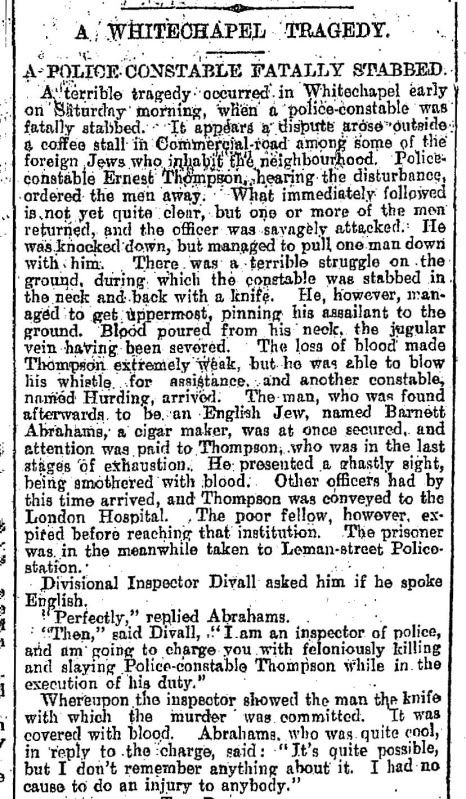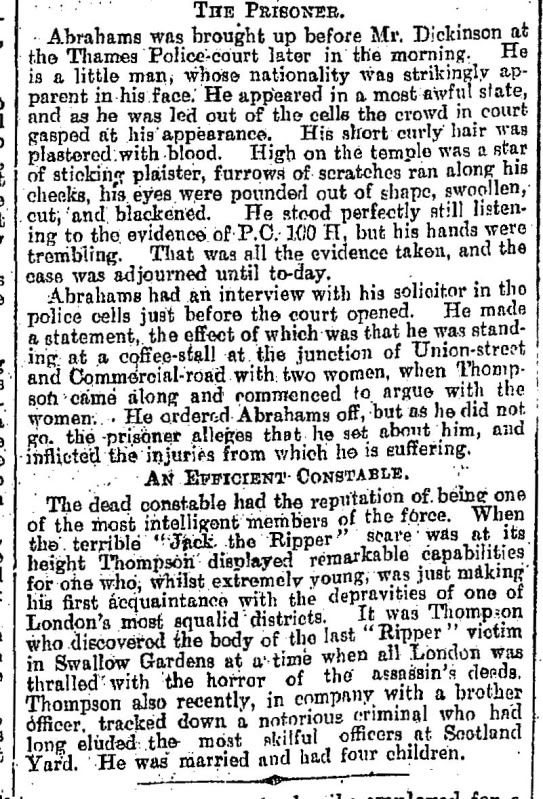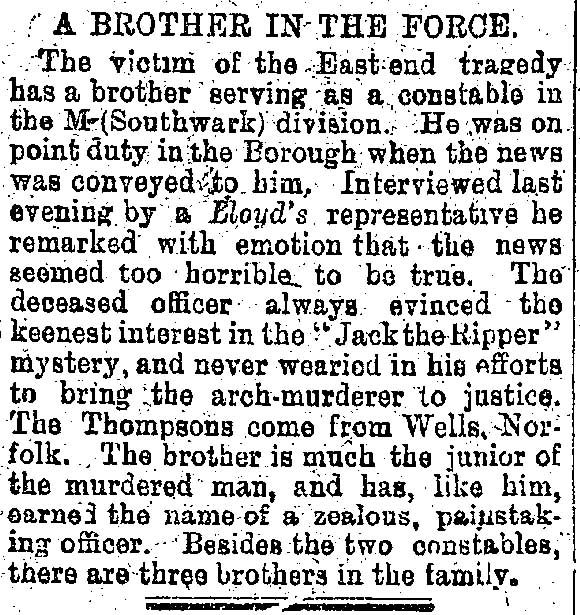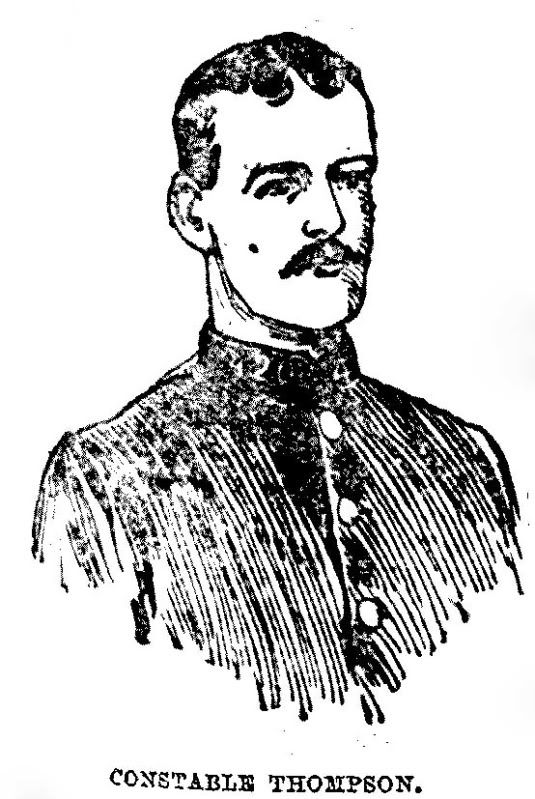City PC Thompson?
Collapse
X
-
In 1901 there was a PC Albert Thompson, 21, at the Borough Police Station. Born Warham (which is close to Wells-Next-The-Sea).
-
Originally posted by jonathan wilson View PostPc Ernest thompson 240 was my great grandfatherand was stabbed to death in 1900 my mum believes that his brother Albert Thompson was in the city police and was in M divison in 1900 Ernest joined on the 29/12/1889 Albert was older and i believe was the officer in 1888 The other E Thompson mentioned is not a relative My grandfather is buried in tower hamletsThe papers believe him to be the man who discovered Frances Coles, Feb 13, 1891.



The Manchester Times, December 7th 1900
Leave a comment:
-
only from my great aunt Jessie Thompson who wrote some memoirs before she died and would have been told about him and the incident by her mother as she was only about 3 when he died the family moved to braintree in essex following his death. We also have a copy of my Great Grandfathers obituary and the murder trial from the london papers dated 1st january 1901 and a photo also.
Leave a comment:
-
Hi Jonathan,
City didnt have divisions in 89, if memory serves me right.Pc Ernest thompson 240 was my great grandfatherand was stabbed to death in 1900 my mum believes that his brother Albert Thompson was in the city police and was in M divison in 1900 Ernest joined on the 29/12/1889
Mets M Division was Southwark.
Monty

Leave a comment:
-
Hello Jonathan,
Welcome aboard.
Wensley spoke well of your great grandfather in his book 40 Years of Scotland Yard, describing his courage.
I'm reading the book now and it's very interesting.
I hope you enjoy your time here.
Leave a comment:
-
 Guest repliedHi Jonathan, and welcome to Casebook....Originally posted by jonathan wilson View PostPc Ernest thompson 240 was my great grandfatherand was stabbed to death in 1900 my mum believes that his brother Albert Thompson was in the city police and was in M divison in 1900 Ernest joined on the 29/12/1889 Albert was older and i believe was the officer in 1888 The other E Thompson mentioned is not a relative My grandfather is buried in tower hamlets
Guest repliedHi Jonathan, and welcome to Casebook....Originally posted by jonathan wilson View PostPc Ernest thompson 240 was my great grandfatherand was stabbed to death in 1900 my mum believes that his brother Albert Thompson was in the city police and was in M divison in 1900 Ernest joined on the 29/12/1889 Albert was older and i believe was the officer in 1888 The other E Thompson mentioned is not a relative My grandfather is buried in tower hamlets
Im sorry to hear of your grandfathers end, but found your connection with PC's of the area and times quite interesting. How do you know of the backgrounds, from your Mum primarily? Are there any specific stories in the family regarding the events in the late 1880's?
Best regards Jonathan.
Leave a comment:
-
Pc Ernest thompson 240 was my great grandfatherand was stabbed to death in 1900 my mum believes that his brother Albert Thompson was in the city police and was in M divison in 1900 Ernest joined on the 29/12/1889 Albert was older and i believe was the officer in 1888 The other E Thompson mentioned is not a relative My grandfather is buried in tower hamlets
Leave a comment:
-
Thank you, Stewart. You are undoubtedly correct regarding Sir Basil. It is extremely sloppy work on his account and relying on Wensley's book for the accurate count or Ripper murders in inexcusable.Originally posted by Stewart P Evans View PostSorry Andy but you are again trying to read too much into secondary sources. This is a sloppy account by Thomson. It is clearly a confusion, combined with a lack of properly internalising his source material (a not uncommon factor in modern Ripper research too). We know the volumes that Thomson used when writing his book as the following bibliography appears at the back -
I have no doubt that there was officially no PC witness. The question is (not based on Thompson's work, btw) could there have been a sighting which was not reflected in official records?
The intriguing aspect now to me does not center around Sir Basil at all but is rather located in the transition from Macnaghten (Aberconway) to Griffiths. Where Macnaghten writes of a PC witness "near Mitre Square," Griffiths changes the location to "in Mitre Court." As Mitre Court is "near" Mitre Square, Griffiths seems to be specifying more clearly Macnaghten's comment which may mean he has additional information regarding such a sighting. If he does, this would tend to lend veracity to the claim of a "PC witness." Of course it could be a coincidence, with "Mitre Court" being an error for "Mitre Square" but it would be a singular coincidence in that the "error" makes perfect geographical sense.
I realize this is not likely but it bears investigation, in my opinion.
Leave a comment:
-
Sloppy
Sorry Andy but you are again trying to read too much into secondary sources. This is a sloppy account by Thomson. It is clearly a confusion, combined with a lack of properly internalising his source material (a not uncommon factor in modern Ripper research too). We know the volumes that Thomson used when writing his book as the following bibliography appears at the back -
and there you have the requisite books for this confusion.
I've said it before, and I'll say it again, the extant official reports clearly show that there was no police officer witness who saw a suspect at or near Mitre Square that night. To try and suggest there was is an exercise in futility.
Leave a comment:
-
Wasn't there a City PC who lived in Mitre Square? I'm not thinking of Morris but rather a serving PC.
Leave a comment:
-
Andy,Originally posted by aspallek View PostThat's very interesting, Monty, because that would be about the time of Lawende's sighting, and indeed, if Harvey was not one of these two people it may have been about the time he was peering into Mitre Square from Church Passage.
Mention of a "covered passage" means this had to be "Mitre Court" (later renamed "Mitre Passage") as the other entrances to the Square are open.
Absolutely right, it can only be one passage.
You may want to note that Blenkinisopp notes his conversation with a man at the same time also, and he was yards away from Mitre Court, in the open.
Monty

Leave a comment:
-
That's very interesting, Monty, because that would be about the time of Lawende's sighting, and indeed, if Harvey was not one of these two people it may have been about the time he was peering into Mitre Square from Church Passage.
Mention of a "covered passage" means this had to be "Mitre Court" (later renamed "Mitre Passage") as the other entrances to the Square are open.
Leave a comment:
-
Andy
Originally posted by aspallek View PostHi Scott. Could you tell me where this is from? Also your previous mention of a sighting in Orange Market?
Thanks.
THE DAILY TELEGRAPH
TUESDAY, NOVEMBER 13, 1888
DORSET-STREET MURDER.
INQUEST AND VERDICT.
DESCRIPTION OF THE ASSASSIN.
Comparatively little that was new was elicited by the coroner's inquiry into the death of Marie Jeanette Kelly. Going beyond the statements that have already appeared in these columns, the principal evidence was that of Mary Ann Cox, residing in Miller's-court, who described a man she had seen entering the court with the deceased. It is stated that the police attach weight to her description, and will circulate it in the usual manner. The account of the man and his attire agrees with some of those statements previously given, and disagrees with others. The Berner-street suspect was described as a very dark man. The Hanbury-street victim was seen in company with a dark foreign-looking man, and a similar description was given of a suspected individual at the time of the Buck's-row murder. It is noteworthy, however, that there were two descriptions given of the suspected Mitre-square and Hanbury-street murderers, which agree in some respects with that furnished by the witness Cox of the man seen in Kelly's company on Thursday night. About ten minutes before the body of Catherine Eddowes was found in Mitre-square, a man about thirty years of age, of fair complexion, and with a fair moustache, was said to have been seen talking to her in the covered passage leading to the square. On the morning of the Hanbury-street murder, a suspicious looking man entered a public-house in the neighbourhood. He was of shabby-genteel appearance and had a sandy moustache. The first of these descriptions was given by two persons who were in the Orange Market and closely observed the man. The City police have been making inquiries for this man for weeks past, but without success, and they do not believe that he is the individual described by Cox. On the other hand the Metropolitan authorities are inclined to attach significance to it. Cox stated that the man who accompanied Kelly to her home carried a can or pot of beer. No trace of this beer has been found in the room, nor of the pewter in the ashes of the grate. Inquiry has equally failed to obtain evidence of Kelly or any person similar to the man described having bought beer at any of the neighbouring public-houses. Considering the amount of drinking on and off the premises of these establishments near midnight the mere absence of evidence on this point would not be surprising in any case.
Monty

Leave a comment:




Leave a comment: